On a job I am working on, a 2 core and bare earth FP200 plus has been run to pick up Motorised Smoke Dampers.
The dampers that arrived onsite are fitted with BEN24 actuators and on looking them up it seems they are a 3-wire system, one wire to rotate to the open position and one to rotate to the closed position with a common return.
If the supply to these actuators is at 24V DC, am I correct to assume that I can use the full size bare CPC of the FP200 plus as the common return and the two cores for each of the "positive" poles or is my understanding of regulation 414.4.5 incorrect?

